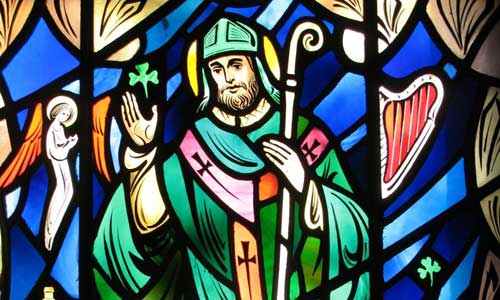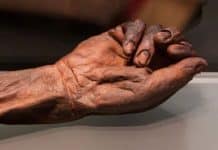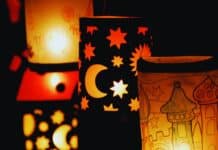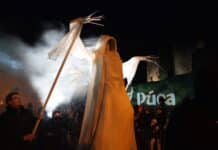Saint Patrick’s Day is upon us and the man most famous for ridding Ireland of ‘evil’ is celebrated the world over. From Hellfire Club to heavenly martyrdom, evil has been at the root of some of Ireland’s most iconic tales and figures including Saint Patrick himself. ANN MASSEY takes a look at seven noted Irish saints and sinners and discovers some are both…

Saint Patrick, Ireland’s Patron Saint
The young Patrick was kidnapped by Irish Pirates who sold him into slavery, where he became a shepherd in County Antrim. Until his escape back to his family, Patrick used to take part in Pagan Worship and rituals including sacrifices.
On the flip side of course, Saint Patrick brought Christianity to Ireland and himself withstood temptation, fighting demons and darkness for forty days and forty nights. This took place on what is now known as Croagh Patrick in County Mayo. Read more about St Patrick here.
Florence Newton, The Witch of Youghal
A sensational witch trial took place in Ireland in 1661, the trial of Florence Newton. Accused of enchanting Mary Langdon, the maid of a prominent figure in town. Her alleged victim became violently ill and suffered seizures and visions as well as vomited nails. The house itself became the target of poltergeist activity.
Newton was also accused of causing the death of her jailer through sorcery, as his widow accused Florence of kissing her husband on the hand shortly before he dropped dead.
So important was the trial that the Irish Attorney General came to Cork to preside and it was assumed that Florence was found guilty and hanged. Presumed because despite well-kept records of the beginning of the trial, the remainder of them vanished completely so we will never know exactly what happened to Florence Newton.
Saint Dympna, The Lily of Eire
Saint Dympna was a young girl from 7th Century Ireland. Her mother was a beautiful Christian woman however her father was a nasty piece of work and pagan. He was not impressed therefore that his daughter took vow a vow and chastity and devotion to God.
A short time later her mother died and her father King Damon descended into grief driven madness, coveting his daughter due to her maternal likeness.
Despite her absconding to Belgium, King Damon found her and beheaded his fifteen-year-old daughter with his sword for refusing to return to his side. Dympna was sainted for her miracles relating to people with mental illness.
William Conolly, The Speaker
In the early eighteenth century, Speaker of the House of Commons in Ireland, William Conolly erected a hunting lodge at the top of what is now known as Montpelier Hill.
By building on top of an ancient burial site and using stones from the remaining cairn, the project was never going to be blessed – no one however, expected the portents of darkness to happen so soon.
With the construction almost completed, including the use of a Menhir for the mantle of the great fireplace, the roof detached and was destroyed in high winds. Locals at the time believed it to be the work of the Devil in punishment for the desecration of sacred ground.
In 1737 members of a secret sect leased the premises from the Conolly family. In a strange twist, the land on which the lodge was built was purchased from Phillip, Duke of Wharton, original founder of the first Hellfire Club and that sect built Dublin’s Hellfire Club on the site of the Lodge.
Saint Oliver Plunkett, Last Victim of the Popish Plot
A well-educated man born to a wealthy family in Meath, Oliver Plunkett was ordained a priest in Rome in the mid-seventeenth century.
He returned to Ireland to undo the damage caused by Cromwell and bring the Irish people back to Catholicism as well as removing drunken and wanton behaviour from the clergy. His efforts, while successful, made him an enemy of both his brethren and supporters of the Crown.
After much time in hiding, he was put on trial and sentenced to execution. Oliver Plunkett was hanged, drawn and quartered on 1 July 1681.
You can see Oliver Plunkett’s decapitated head here.
Saint Kevin, Murderer Most Devout
Saint Kevin of Glendalough is known for the founding of the Wicklow Monastery and while he may have seemed angelic at birth and destined for great things, he had sociopathic tendencies and was sent to the monastery as a boy of seven. Hating people, he lived in solitude until he was forced into the community by his Holy Order.
The young man was subjected to attempts at seduction by a local woman. The temptress used to dress provocatively in red and follow the celibate Kevin until one day she followed him into the woods and pushed him too far.
Desperate not to fall to temptation, Kevin threw himself into a bed of nettles and in temper tore some off and beat Kathleen towards the edge of the lake, whereupon he forced her into the water and drowned her.
Darkey Kelly, Ireland’s First Serial Killer
Darkey Kelly was a Dublin brothel keeper in 1760. She was arrested for the murder of shoemaker John Dowling on Saint Patrick’s Day. When authorities raided her premises, they discovered the rotting corpses of five more men hidden in the cellars of the Maiden Tower brothel.
She was also said to be the lover of one of the most prominent members of the Hellfire Club, the Sheriff of Dublin, believed to have slain their lovechild in a Satanic sacrifice and then accused the murderess of Witchcraft.
Darkey Kelly was sentenced to death, partially hanged and then burned at the stake at Gallows Street.







